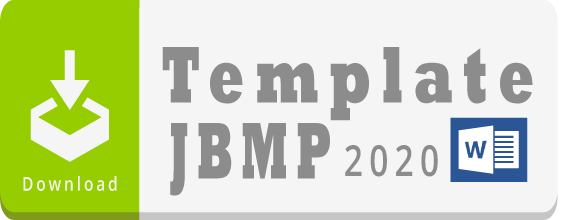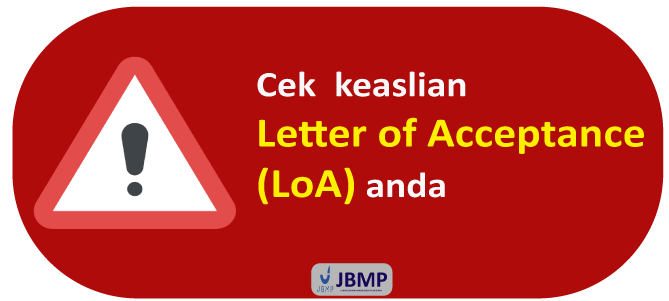Pengembangan Konten E-Learning Untuk Meningkatkan Pembelajaran Bermakna di Sekolah Sekolah Menengah
 ), Ulfia Rahmi(2),
), Ulfia Rahmi(2), (1) Universitas Islam Negeri Imam Bonjol Padang
(2) Universitas Negeri Padang
 Corresponding Author
Corresponding Author
DOI : https://doi.org/10.24036/jbmp.v10i2.115852
Full Text:
 Language : id
Language : id
Abstract
Tujuan penelitian ini adalah mengembangkan konten e-learning untuk meningkatkan belajar bermakna di sekolah menengah atas. Hal ini didasari oleh kemampuan merancang dan mengembangkan konten pembelajaran yang kurang memperhatikan prinsip instructional message design. Akibatnya siswa sulit memahami dan memaknai materi. Pengembangan konten e-learning ini menggunakan model ADDIE. Analisis dilakukan terhadap (158) siswa sekolah menengah atas dan materi ajar Biologi. Selanjutnya mendesain konten berdasarkan prinsip (8) instructional message design. Pada tahap develop divalidasi oleh (3) pakar. Hasilnya diperoleh konten e-learning yang valid, yang sesuai dengan karakteristik siswa sekolah menengah atas, dan telah menerapkan prinsip instructional message design. Novelty penelitian ini adalah pada e-learning content used prinsip instructional message design.
Keywords
References
Afify, M. (2018). E-learning content design standards based on interactive digital concepts maps in light of meaningful learning theory and constructivist learning theory. JOTSE, 8(1), 5–16.
Allen, I. E., & Seaman, J. (2006). Making the Grade: Online Learning in the United States.
Ansyar, M. (2015). Kurikulum; Hakikat, Fondasi, Desain dan Pengembangan, 486–489.
Bishop, M. J. (2014a). Instructional message design: Past, present, and future relevance. In Handbook of research on educational communications and technology (pp. 373–383). Springer.
Bishop, M. J. (2014b). Reconceptualizing instructional message design: Toward the development of a new guiding framework. In Design in educational technology (pp. 143–159). Springer.
Brady, L., & Kennedy, K. (2013). Curriculum construction. Pearson Higher Education AU.
Branch, R. M. (2009). Instructional design: The ADDIE approach (Vol. 722). Springer Science & Business Media.
Brown, A. H., & Green, T. D. (2015). The essentials of instructional design: Connecting fundamental principles with process and practice. Routledge.
Clark, R. C., & Mayer, R. E. (2016). E-learning and the science of instruction: Proven guidelines for consumers and designers of multimedia learning. John Wiley & Sons.
Collett, P., & Steyn, C. (2017). Using African Designs in Virtual Manipulatives for Geometrical Concept Development. In Bridges 2017 Conference Proceedings (pp. 455–458). Tessellations Publishing.
Crompton, H., & Burke, D. (2017). Research trends in the use of mobile learning in mathematics. In Blended Learning: Concepts, Methodologies, Tools, and Applications (pp. 2090–2104). IGI Global.
Effendi, M; Effendi, H; Effendi, H. (2017). THE ROLE OF LOCUS CONTROL AND LEARNING STYLES IN THE DEVELOPMENT OF THE BLENDED LEARNING MODEL AT PSU. International Journal of GEOMATE, 13(37), 75–80. Retrieved from http://www.geomatejournal.com/articles/2017/13/37
Fleming, M. L. (1993). Instructional message design: Principles from the behavioral and cognitive sciences. Educational technology.
Fleming, M. L., & Levie, W. H. (1978). Instructional message design: Principles from the behavioral sciences. Educational Technology.
Gambari, A.I; Shittu, A. T; Ogunlade, O.O; Osunlade, O. R. (2017). Effectiveness Of Blended Learning And ELearning Modes Of Instruction On The Performance Of Undergraduates In Kwara State, Nigeria.pdf. Malaysian Online Journal of Education Science, 5(1), 25–36.
Ghirardini, B. (2011). E-learning methodologies: A guide for designing and developing e-learning courses. Food and Agriculture Organization of the United Nations.
Grabowski, B. L. (1991). Message design: Issues and trends. Instructional Technology: Past, Present and Future, 202–212.
Hsia, J.-W., Chang, C.-C., & Tseng, A.-H. (2014). Effects of individuals’ locus of control and computer self-efficacy on their e-learning acceptance in high-tech companies. Behaviour & Information Technology, 33(1), 51–64.
Joo, Y. J., Lim, K. Y., & Kim, J. (2013). Locus of control, self-efficacy, and task value as predictors of learning outcome in an online university context. Computers & Education, 62, 149–158.
Khan, B. H. (2004). The People—Process—Product Continuum in E-Learning: The E-Learning P3 Model. Educational Technology, 44(5), 33–40.
Lee, A., Mwaikambo, L., & Jayarajan, N. (2016). Making content meaningful: a guide to adapting existing global health content for different audiences.
LEE, T. T., SHARIF, A. M., & RAHIM, N. A. (2018). Designing E-Content for Teaching Basic Chemistry Concepts in Higher Education: A Needs Analysis. Journal of Turkish Science Education (TUSED), 15(4).
Ma’mur, M., Warsono, W., & Suyanto, E. (2013). Pengembangan Model Pembelajaran Blended Learning pada Matakuliah Konsep Teknologi Informasi. Jurnal Teknologi Informasi Komunikasi Pendidikan (Old), 1(4).
Mayer, R. E. (2009). Multimedia Learning. Multimedia Learning (2nd ed., Vol. 1). New York: Cambridge University Press. https://doi.org/10.1017/CBO9781107415324.004
Pattnayak, J., & Pattnaik, S. (2016). Integration of web services with e-learning for knowledge society. Procedia Computer Science, 92, 155–160.
Pritchard, A. (2013). Ways of learning: Learning theories and learning styles in the classroom. Routledge.
Rahmi, U., Effendi, Z. M., & Ansyar, M. (2017). The Development of Message-Design Model in Blended Learning. The Asian Journal of Technology Management, 10(1), 1.
Rahmi, U., Mawardi Effendi, Z., & Ansyar, M. (2017). The Development of Message-Design Model in Blended Learning. The Asian Journal of Technology Management, 10(1), 1–9. https://doi.org/10.12695/ajtm.2017.10.1.1
Rasouli, A; Rahbania, Z; Attaran, M. (2016). Students’ Readiness for E-learning Application in Higher Education. Malaysian Online Journal of Educational Technology, 4(3), 51–64.
Reigeluth, C. M. (1983). Instructional design theories and models: An overview of their current status. Routledge.
Rotter, J. B. (1954). Social learning and clinical psychology.
Schaal, S. (2010). Cognitive and motivational effects of digital concept maps in pre-service science teacher training. Procedia-Social and Behavioral Sciences, 2(2), 640–647.
Slavin, R. E. (1994). Educational Psychology Theory Into Practices. Edisi4. Boston: AIIyn and Bacon.
Slavin, R. E., & Davis, N. (2006). Educational psychology: Theory and practice.
Smaldino, S. E., Lowther, D. L., Russell, J. D., & Mims, C. (2008). Instructional technology and media for learning.
Tuncer, M., & Bahadir, F. (2014). Effect of Screen Reading and Reading from Printed Out Material on Student Success and Permanency in Introduction to Computer Lesson. Turkish Online Journal of Educational Technology-TOJET, 13(3), 41–49.
Utami, I. S. (2018). The Effectiveness of Blended Learning as an Instructional Model in Vocational High School. Journal of Educational Science and Technology (EST), 4(1), 74–83.
Watkins, R., & Corry, M. (2013). E-Learning Companion: Student’s Guide to Online Success. Cengage Learning.
Yukselturk, E., & Bulut, S. (2007). Predictors for student success in an online course. Journal of Educational Technology & Society, 10(2).
Zhu, C. (2012). Student satisfaction, performance, and knowledge construction in online collaborative learning. Journal of Educational Technology & Society, 15(1), 127.
 Article Metrics
Article Metrics
 Abstract Views : 1235 times
Abstract Views : 1235 times
 PDF (Bahasa Indonesia) Downloaded : 491 times
PDF (Bahasa Indonesia) Downloaded : 491 times
Refbacks
- There are currently no refbacks.




